The Inside of Potala Palace - Check the Detailed Interior Travel Guide for You
Potala Palace is the most visited place in Tibet and is a place that will keep you mesmerized for a lifetime. It is a modern-day World Cultural Heritage site that preserved due to its religious and traditional history. It was used to be the winter palace of the Dalai Lama since the 7th Century and has been the center of Tibetan culture for centuries. This beautiful Potala Palace is built on the Red Mountain in the middle of Lhasa Valley at the height of 3,700 meters. The exterior of the Palace stands out with the White and Red Palace making for an eye catching architecture of marvel and tradition.
Layout of Potala Palace Inside
The interior of Potala Palace is at an immense structure of over 130,000 square meters. The decorations and design are full of creativity. Once it housed the great Dalai Lama and his large staff, and now is the central office for the Tibetan government.
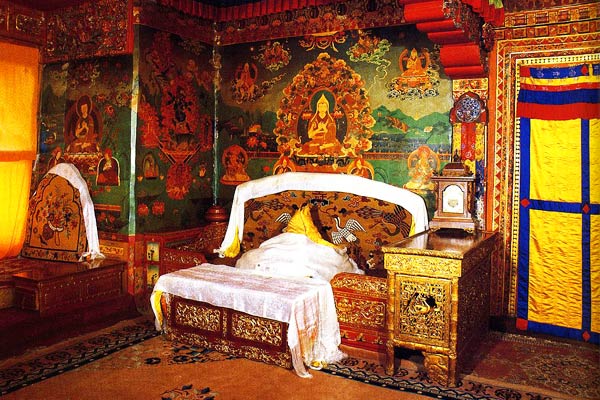 The fourteenth Dalai Lama study and meditation seat
The fourteenth Dalai Lama study and meditation seat Since the Potala Palace was founded in 637 by Songtsan Gampo according to evidence, the structure is simple and not of the modern advanced interiors. The columns are what holds the structure together similar to the halls in ancient Greece and Egyptian temples. The walls are seen to be slopping inwards and an arrangement of stone built against the wall to strengthen it.
There are in total four walls and four gates, a perfect square and thousands of rooms inside which makes the interior a fascination you only see in movies and read about in books. The interior is exceptionally complex, and hence you need to spend hours to explore the hidden treasures inside the Palace. It is recommended to wear flat and comfortable shoes as there is a lot of walking inside.
There are seven floors in total in the White Palace that divided into east and west. A zigzag porch outside the White Palace gives access to the entrance. The east contains the main sanctuary called Cuoqinsha which is 717 square meters being on the fourth floor. The 5th and 6th levels are the Regents Office and living quarters. The last floor, the 7th floor was the Winter Palace of the Dalai Lama, and in here there is a lot of brightness and hence is called ‘The Hall of the Sun.’ The west part of the White Palace contains governmental offices, a school, and an assembly hall.
There is a yellow building at the side of the White Palace which is where banners of holy symbols are hung during New Year festivals. The White Palace is connected to the Red Palace by the Zhasha building, where almost 25,000 monks live in total. The Zhasa building is located in the west of the Red Palace but looks like a part of the White palace due to its White Walls.
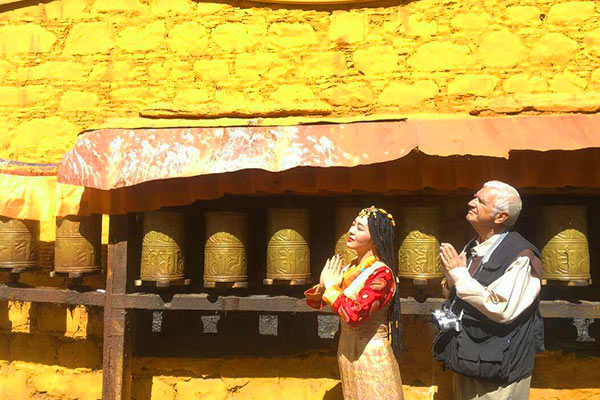 There is a yellow building that tourists like taking photos here
There is a yellow building that tourists like taking photos hereThe Red Palace is five floors high and is complicated and more significant in comparison to the White Palace. It covers a floorage of 16,000 square meters. It has four meditation halls and four central halls which are dedicated to the 5th Dalai Lama. You will be walking through several winding passages and small galleries as you are inside. The main central hall is the Great West Hall which has four chapels. Above these chapels are galleries which have a uniqueness about each.
There is a chapel North in the front of these halls which contains an ancient shrine to Avalokiteshvara with a passage leading to the sacred Dharma caves. There are 35 chapels and dozens of shrines and gold stupa tombs of the Dalai Lamas. In the Red Palace, there are many memorial halls dedicated to Tibet’s leaders.
Travel Route Inside Potala Palace
All trips to the Potala Palace start from the main entrance of Potala Palace, where the ticket is purchases. From here you will travel to the East Courtyard followed by the Gallery of the White Palace. Here you will see the three main halls in White Palace which are the East Youjiyuanman Hall, the Sunlight Hall and the Hall of Maitreya. Then you can move on to the golden top. After witnessing the marvelous golden top, you will follow the guide to the remaining halls of the Tancheng Hall, the Shushengsanjie Hall, and the Longevity Hall.
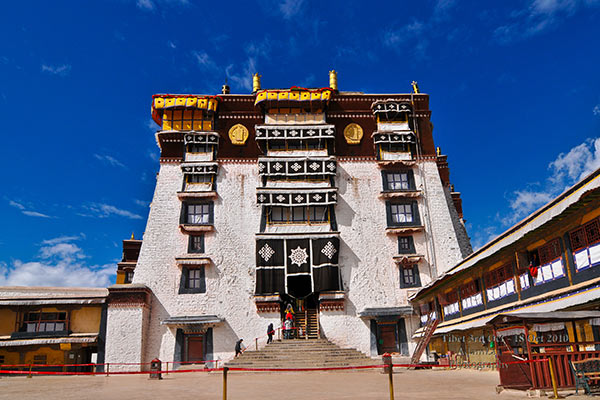 White Palace
White Palace Then you will take down momory lane to go back in time to the Dalai Lama’s stay in Potala Palace. You will visit the Stupa Hall of the 13th Dalai Lama, the Shanshi Hall, the Stupa Hall of the 7th Dalai Lama, the Hall of Guanyin, the Stupa Hall of the 8th Dalai Lama, the Stupa Hall of the 9th Dalai Lama and finally the Silun Hall.
You are then taken inside the chapel North of these halls where you will see the Hall of the Amitayus Buddha and down the narrow passage to Fawang Cave.
After being amazed by the remaining beautiful halls of the Puxianzhuisui Hall and the Xiangluo Hall, you will then step into the Gallery of the Red Palace which outlines the beauty of the Patola Palace and walk into the West Youjiyuanman Hall, the Putidaocidi Hall, the Chiming Hall, the Stupa Hall of the 5th Dalai Lama and finally into the Shixi Hall.
What to See Inside Potala Palace
The Potala Palace is divided into the White and Red Palace, and with thousands of rooms, it is better if you understand what’s worth seeing and what’s not. With over 1000 rooms in the palace, only more than 20 are open to the tourists.
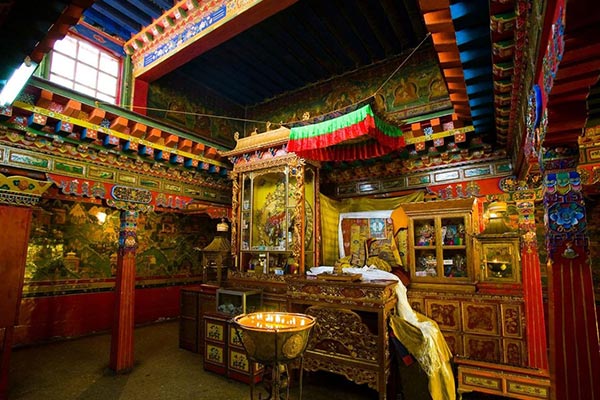 There is full of Tibetan charm inside Red Palace
There is full of Tibetan charm inside Red Palace Inside the Potala Palace, you will witness decorations of stunning paintings based on landscapes, historical legends, Buddhist stories and Potala Palace. Please remember to take a close look at Cuoqinsha on the fourth floor of the White palace as it was in this floor that important Buddhist ceremonies such as the enthronement of the Dalai Lama had taken place. It is recommended to go upstairs to the White Palace to enjoy the sunshine in the Sunlight Hall.
It is wonderful to spend more time in the Red Palace due to the more prominent ground to cover and the marvelous structures which will captivate your attention. You can witness the stupas of Dalai Lama in the tenth to the thirteenth floor, the Buddhist hall and the chanting sutra hall in the seventh to the ninth floor. Supreme Buddhist ceremonies are held in the Red Palace making you feel peaceful with the spiritual significance it has in Tibet. In the main Central hall, you can see miniatures depicting events of the fifth Dalai Lamas life. Looking towards the east wall, you can see a famous scene of his visit to the Shunzhi Emperor in Beijing is described. A special cloth is wrapped in the columns and pillars in this hall. Each chapel in the main central hall has something unique inside.
The North Chapel has a crowned Sakyamuni Buddha on the left and the Fifth Dalai Lama on the right. There is also the gold stupa tomb of the Eleventh Dalai Lama who died as a child. You will notice several scriptures covered in silk.
The South Chapel is dedicated to Padmasambhava, the 8th Century Indian magician, and saint. This center of attraction has several manifestations near it. The East Chapel is for Tsong Koopa, founder of the Goplag tradition. You will notice lamas from Sakya Monastery beside the central figure showing the traditions of Tibet. The West Chapel has five golden stupas. Don’t miss the 14-meter high stupa of the fifth Dalai Lama which is built with 3700 kilograms of gold and about 15,000 diamonds. Above the West Chapel is the first gallery which has large windows. Between the windows are marvelous murals showing Potala's construction.
You can have refreshments and buy souvenirs in the second Gallery which leads you to the central pavilion. The third gallery has many dark rooms, containing several bronze statues and the chanting hall of the Seventh Dalai Lama. Here is the connection to the Sants chapel and the Devanghsar. West of the Great West Hall has the tomb of the 13th Dalai Lama, which is 14 meters in height. There are elephant tusks from India, porcelain lions and vases near the tomb as devotional offerings.
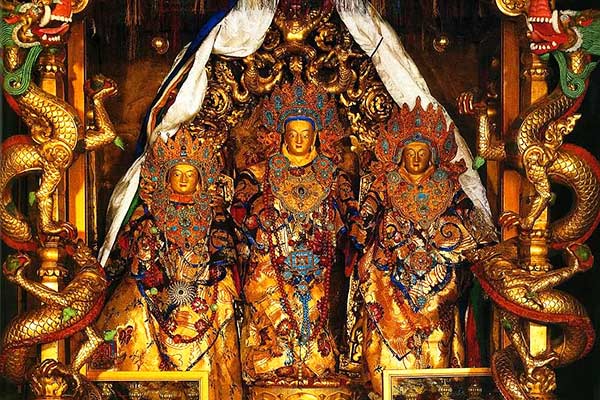 Bronze statues inside Ptala palace
Bronze statues inside Ptala palace The Dhammassami Hall has the statue of Sontzen Gampo and his wives Princess Chizun and Princess Wenchen. Join your hands together at the Saint Avalokitesvara Hall where the statue of Avalokitesvara is carved from a piece of entire sandalwood.
Book Your Potala Palace Tour in Advance
A trip to Lhasa, including the visit to Potala Palace, will keep you dreaming of going back to its enchanting atmosphere and extraordinary artifacts. However, the average number of visitors is restricted to 1,600 a day. Therefore, it is suggested to book the ticket of Potala Palace in advance. Joining in our Lhasa city group tour is a good choice for you can explore this palace with our Tibetan travel guide, who will share the knowledge of the Potala Palace, as well as their hometown Tibet.
 BACK
BACK
0 Comment ON "The Inside of Potala Palace - Check the Detailed Interior Travel Guide for You"